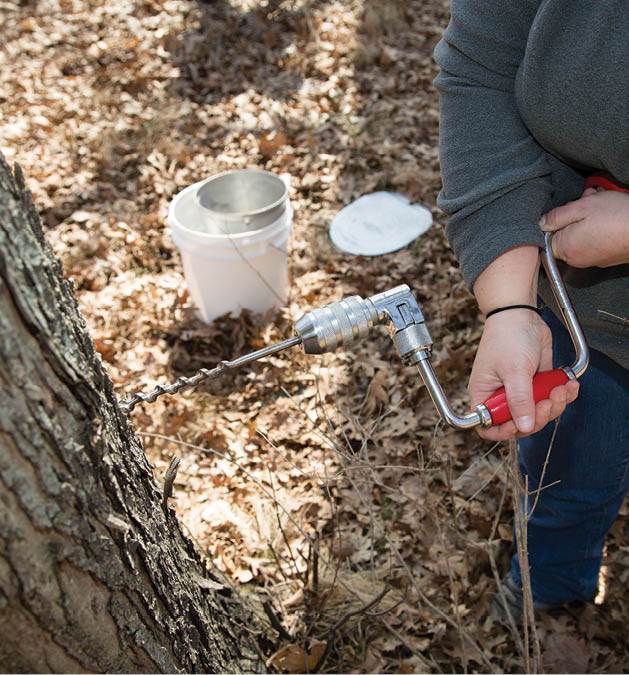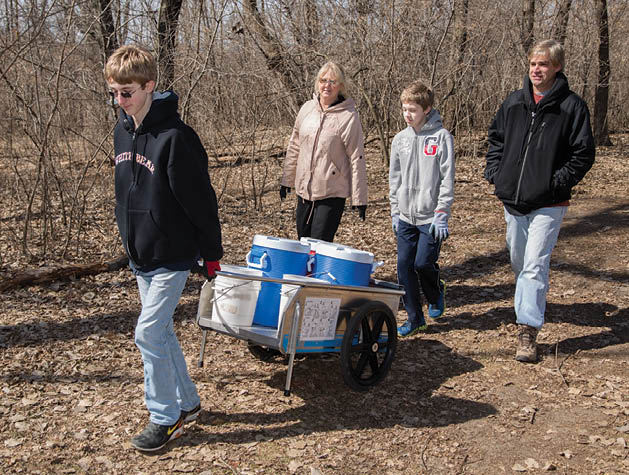Maple syrup. It tastes great on pancakes, waffles and bacon, not to mention it is a delicious ingredient in many recipes. Most people know the source of maple syrup, but for at least 30 years, the folks at Tamarack Nature Center in White Bear Township have been educating school groups and the public on just how this sweet treat comes to be.
“In 1979, Tamarack Nature Center started as a small trailer on the grounds,” says Melanie Harding, naturalist/volunteer coordinator for Ramsey County Parks and Recreation. “We believe it was shortly after that, in the early 1980s, that maple syrup production and programs started.”
Maple Trees
In order to conduct the maple syrup season and harvest correctly, Tamarack needs an abundance of trees to get the job done. They have identified approximately 115 trees on the property that are tagged as potential tapping trees. “In a typical season, we place 75-90 taps in anywhere between 50 and 60 trees,” Harding says. “Trees can have multiple taps, too. A larger tree can handle more taps and give us more sap.”
“What we’re looking for when tapping trees is good flow, above freezing temperatures during the day and below freezing at night. And it’s that back-and-forth temperature that causes the sap to start flowing,” Harding says.
Tapping
Using the basic tools of a hand brace, drill bit and a spile (a thin piece of metal that acts as a spout for the sap to run down), the staff at Tamarack prepares the trees to receive their sap by drilling a one-and-a-half- to two-inch hole into the tree, cleaning out the wood shavings from the hole, and then taking a hammer to tap in the spile. The last piece to the puzzle is hanging a two-gallon bucket to collect the sap.
The amount of sap each tree provides can vary due to factors such as the weather, the health of the tree, the age of the tree and the previous year’s season, where it is located, and what the soil conditions are like. Harding mentions that it is specific to each individual tree. “We have trees on the property that we call good runners,” she says. “We know, typically, that those trees are ones that we’re going to get a lot of sap from, and there’s a handful of those where we just make sure we always have those fully tapped and are taking advantage of the good flow.”
If everything is going well, the trees will produce approximately two gallons of sap, which is collected daily. Harding says that on a really good day you could have two-to-four gallons, but it takes a lot of sap to make syrup. In fact, to make one gallon of syrup, the center must collect 50 to 60 gallons of sap.


The Scientific Explanation
“What’s happening is basically we’re tapping into a natural process that the tree is already doing,” Harding says. “[The tree is] starting to send its stored sap up from the roots, and from the trunk of the tree up to the leaves to the buds, so that it can leaf out and start making more sugar. We’re trying to catch that sap along the way. Once it gets up there and the tree actually starts budding out, the chemistry of the tree changes and the flavor changes. Once that happens, the season’s over.”
The season is dependent on whether or not Mother Nature will cooperate. The center follows a seasonal calendar schedule and when late February hits, they shoot for four-to-six weeks of maple syruping, and usually end the programs around the middle of April. However, many factors go into whether or not a tree is ready to be tapped and how much syrup it will produce.
Getting Kids Involved
With such a lengthy process to obtain just one gallon of syrup, Tamarack takes on 35 volunteers to assist the staff in obtaining sap and making the syrup; each volunteer is asked to commit to a minimum of three sessions. Once the season gets going, the program is open to the general public. But, the best part of the season, for Harding, is helping educate students from Otter Lake Elementary and other schools on how and where it is that the maple syrup actually comes from.
“As school groups start coming, they tap trees as part of their school experience, so when the groups come, the kids are actually out there tapping trees,” Harding says. “I would estimate 800 students, families and adults come here during each maple season through school and public programs, and volunteer programs.”
For Harding, the best part about the process of gathering maple syrup and creating a successful program is the general enjoyment from the volunteers and school groups. “Everybody gets excited about being part of the process,” Harding says. “The process is just so neat [because of] the fact that at the end there’s going to be this really beautiful, yummy product that we’re all going to enjoy and benefit from. I think it draws volunteers, it draws the public, and it draws an interest because there’s this tangible at the end that is really just literally sweet.”
A Family Affair
For some families, the public maple syrup program gives them an excuse to spend time together and truly enjoy nature. The Barton family even moved to the area specifically to be part of what Tamarack has to offer.
“We specifically moved to this neighborhood to be by Tamarack,” says Lisa Barton of her family that includes her husband Jim and two sons, Connor, 16, and Aaron, 13. “We’ve been here 19 years and we kind of evolved with Tamarack. The kids have been to just about everything when they were little. [We thought] this would be something fun we could do together. Hiking in the woods, get some exercise and getting some family time.”
How to Make Maple Syrup
1. Start by tapping into a sugar, red or silver maple tree by drilling into the tree a one-and-a-half to two-inch hole with a drill bit.
2. Clean the hole of all wood shavings. Take a hammer and drive a spile into the hole.
3. Hang a bucket to collect the sap.
4. Take the collected sap (40–60 gallons to make one gallon of syrup) and over a wood fire, boil the sap until all the water evaporates.
5. Move the process to a stovetop indoors and slowly boil to 219 degrees, then take it off the heat. (Do not go over 219 degrees or the syrup will crystallize.)
6. Bottle the syrup to preserve it. Or, pour it over snow and eat, as they do at Tamarack.

Sap to Syrup
March 12, 19 and April 2
1–3:30 p.m. ongoing
$7 per person
Pre-registration required
To find out how to tap your own maple tree, visit tapmytrees.com.









